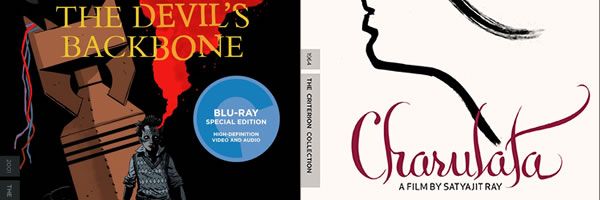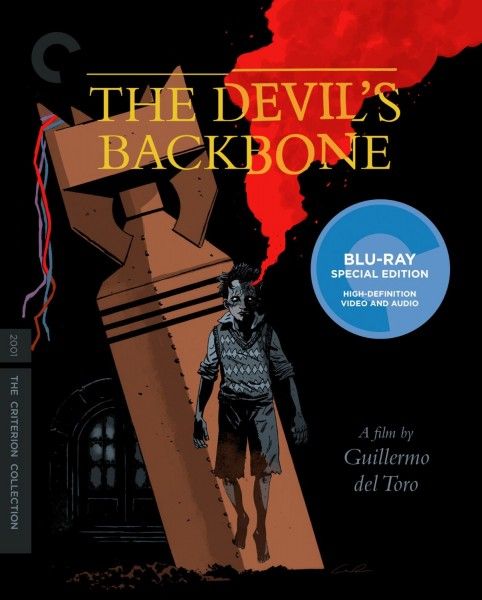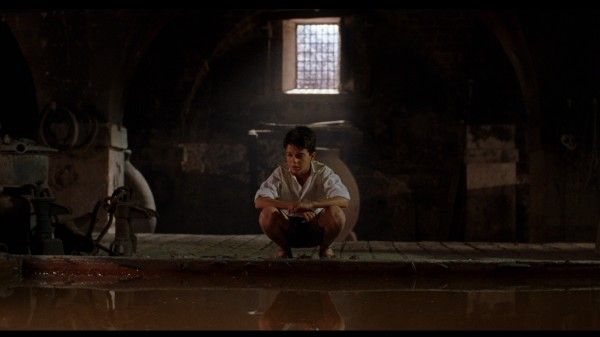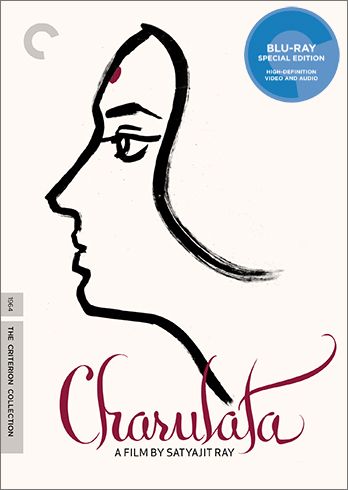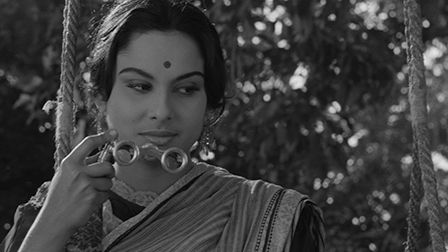It’s funny how Guillermo del Toro is someone that geeks obsess over, but hasn’t totally crossed over into the mainstream. This year saw the release of his Pacific Rim, which made over $400 Million worldwide, but was initially considered a disappointment because of it didn’t open to gangbuster numbers. Rim is an entertaining film, but one of the reasons why fans are so passionate about the man is because of his Spanish-language films, and Criterion has released one of his best: The Devil’s Backbone. The company has also put out Satyajit Ray’s Charulata, and my review of both on Blu-ray follows after the jump.
Taking place in 1939 during the Spanish Civil War, The Devil’s Backbone recounts how ten-year-old Carlos (Fernado Tielve) is left at an orphanage after his parents are killed and his tutors have joined the war effort. Reluctant to accept his new home, Carlos is assigned the bed of a missing student, Santi — whom many of the students fear is dead — provoking the local bully Jaime (Inigo Carces) to make things hard on Carlos. But after a late-night adventure to prove his mettle, Carlos sees a little boy's ghost, whom he figures must be the lost boy — and who frightens him off when the ghost tells him "some of you will die."
All the while, the orphanage's laborer Jacinto (Eduardo Noriega) is trying to find the school's hidden gold, which one-legged headmistress Carmen (Marisa Paredes) is holding for the revolutionaries. She takes care of the rebels, as her dead husband was a supporter, but now her home life consists of a twisted relationship with both ex-pupil Jacinto and the impotent doctor Casares (Frederico Luppi), who has spent decades nursing a crush on her. With the war nearby, things grow increasingly dangerous for the rebellion-supporting teachers, who feel it is time to leave their area. But the mystery of the dead pupil and the search for the gold must continue before anyone can leave.
W.C. Fields always joked about never working with children or animals, but he had a point: They're the least disciplined of co-stars and require the utmost patience. So when a director manages to get a good, unaffected performance out of a child actor it seems like a small miracle. And yet del Toro does so in The Devil's Backbone with an entire school of youngsters, seamlessly blending the stories of both the children and the adults with the thematic elements of youthful imagination, horror, romance, and war, all without missing a beat.
Del Toro says he loves melodrama, and it shows as some of the twists and perversity of characters could easily have been found in a Douglas Sirk film. But the director's command of the story keeps all the elements in play and never over-the-top. Maybe it's because del Toro is an avid comic book fan, and if he has learned anything from his hobby it's a sense of framing and how to create striking visuals, which keeps the story constantly involving and inventive. Working with director of photography Guillermo Navarro, The Devil's Backbone is gorgeous and surreal, with many wild ideas and imagery — one of the best used is a defused bomb stuck in the middle of the orphanage's courtyard, and though it becomes a focal point of the story, the image is so potent it feels Buñuelian.
That said, perhaps the most interesting thing about the film is how it views the supernatural, recognizing that great evil does not come from some "other," but from inside. The story plays with the surreal, but as the tagline of the movie suggests (rather fittingly for a picture tangentially about war and strife), "The living will always be more dangerous than the dead."
Criterion’s Blu-ray release of The Devil's Backbone presents the film in a new widescreen transfer (1.85:1) and in a DTS-HD 5.1 Master audio in the original Spanish with optional English subtitles, while there’s also a subtitle track with storyboard comparisons. The transfer is stunning, and the Criterion touch shows. The film comes with the 2004 commentary that del Toro recorded for the second DVD edition of the film, and he’s very precise about what he wants to say, and goes deep with his influences and his ideas about the film. It’s a great track.
Kicking off the supplements is a new introduction by del Toro (1 min.), which is followed by an new interview with the director about the film (14 min.). Then there’s a 2004 making-of called “Que es un Fantasma?” in Spanish with optional subtitles (27 min.). New is a 2010 interview with dol Toro called “Spanish Gothic,” (18 min.), which connects this film to del Toro’s Pan’s Labyrinth. Slightly revised from the previous editions is “Director's Notebook.” Which shows notes and then offers video comments from the director. Also new is the piece “Designing The Devil’s Backbone” (12 min.), where del Toro talks about the craftsman he worked with to design the effects and art direction. Four deleted scenes (4 min.) with optional director commentary, and six multi-angle sketch and storyboard to screen comparisons (12 min.) are also included, as is an interview with Spanish Civil War scholar Sebastiaan Faber (14 min.) and the film’s theatrical trailer round out the supplements.
Satyajit Ray’s Charulata follows a married couple. Bhupati Dutta (Shailen Mukherjee) is married to a younger woman, and spends his time running a newspaper. He’s moneyed, so he wants to make a paper that reveals the truth, and is one of the first to be critical of the government. Charulata (Madhabi Mukherjee) is his wife, and she spends most of her days on her own. Things change when Bhupati’s cousin Amal (Soumitra Chatterjee) comes to live with them. Bhupati wants Amal to keep an eye on Charu, and so the two spend time together. Amal fancies himself a writer, and so she encourages him, but she’s also a little competitive as she thinks of herself as a writer as well. As tensions rise, everything is kept polite, while Bhupati finds that he’s been stolen from by a trusted associate.
A film of masterful but playful tension, Charulata is minor Ray, but he perfectly creates a respectable romantic triangle with well-defined characters. Ray also understands camera, and so when Amal and Charu go out for a picnic outside, there’s a moment when the camera breaks free and has as much fun as the characters. It’s such precise smart filmmaking. The film was an adaptation of Nastanirh by Rabindranath Tagore, and it feels like a great adaptation in that there’s always layers of subtext, though there’s an economy in the storytelling. It’s a fully realized piece, and it features the humanity that defines Ray’s work. But it’s hard to compare it to his Apu trilogy, which is one of the great series in cinema. It’s a really good film by a master director.
The Criterion Blu-ray presents the film in full frame in a monaural soundtrack. The picture quality is excellent, and there’s no noticeable scratches or damage. Ray was a master of framing and lighting so the contrasts are heavenly in this black and white film. There’s new interviews with stars Mukherjee and Chatterjee (17 min.), with film scholar Moinak Biswas on the film’s adaptation (24 min.) from the Tagore novella, and a 1966 audio interview with Satyajit Ray on his process (13 min.).

